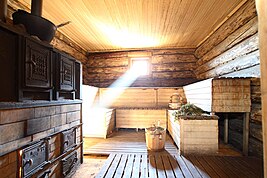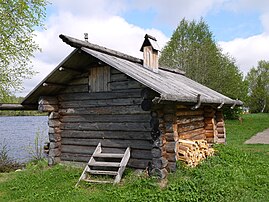A banya is a Russian wooden house with a steam room. It also refers to bathhouse.[1] The banya has also a wood stove to make heat. The main idea of banya is to cause sweat in the bathers.[2]


Usually, the banya (wooden house) is near a river. The bathers jump into the river to cool down after being in the banya.
History
changeIn 440 b.c.e., the Ancient Greek history writer Herodotus wrote about people who live in what is Russia today.[2]
One early mention of the banya is in the Königsberg Letopis.[3] The first full description of a banya is in the East Slavic Primary Chronicles of 1113.[3]
At some times in history, women would go to the banya to give birth to babies. After a funeral, the friends and family of a dead person sometimes go to a banya together.[2]
Throughout Russian history, the banya has been used by people in all classes.[4] Poor workers would get clean in a banya after work.[4] Rich Russians sometimes had private banya.[4] Sometimes, the bather will jump into a river or a pile of snow instead.[2]
Today, banya have separate places for men and women. Bathers do not have to be naked.[4]
Common rules
changeBanya have three rooms: a changing room or predbannik where people change clothes, a washing room, and steam room or parilka.[5]
If the banya is for men and women, bathers should wear bathing suits. If the banya has separate places for men and women, bathers are usually naked.[2]
Process
changeBanya are often hotter than 93°C.[5]
Bathers sit on a small mat to protect their skin from the hot wood. Bathers usually wear felt hats while they sit in the banya. During the banya bath, bathers use a broom or besom. Bathers hit each other with the branches like a massage. Sometimes friends hit each other with branches. Sometimes a professional masseuse does. The last part of the banya is when someone throws a bucket of cool or cold water on the bather.[6]
The biggest difference between a banya and sauna are that the banya has steam and most saunas use dry air.
Health
changeStarting in the 1800s, doctors and scientists decided to study the banya. They already had an idea that it was good for health. Most of their studies were not good by today's scientific rules, but they told many people to go to the banya for their health.[2]
Folklore
changeIn Slavic mythology there is a spirit called a bannik that lives in the banya under the bench. The bannik throws hot water or hot rocks at rude bathers.[4]
Related pages
changeReferences
change- ↑ Ethan Pollock (2019). Without the Banya We Would Perish: A History of the Russian Bathhouse (Abstract). Oxford University Press. doi:10.1093/oso/9780195395488.001.0001. ISBN 9780195395488. Retrieved July 11, 2021.
- ↑ 2.0 2.1 2.2 2.3 2.4 2.5 Tatyana Leonov (August 4, 2020). "The significance of the Russian 'banya'". BBC Travel. Retrieved July 11, 2021.
- ↑ 3.0 3.1 Aaland, Mikkel (1998). "The Russian Bania. History of the Great Russian Bath". Cyber-Bohemia.
- ↑ 4.0 4.1 4.2 4.3 4.4 Suemedha Sood (November 29, 2012). "The origins of bathhouse culture around the world". BBC Travel.
- ↑ 5.0 5.1 "An Easy Guide to Russian Banya Steam Bath". Vegan Trekker. 2019-02-21. Retrieved 2021-07-10.
- ↑ Katie Warren (August 7, 2019). "I visited a 200-year-old Russian bathhouse in Moscow, where I paid $85 to be whacked with branches and doused in ice-cold water. It was the most memorable part of my trip". Business Insider. Retrieved July 11, 2021.